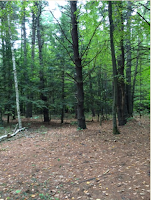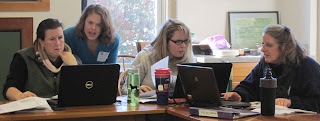Okay Now That We Have Collected the Data, What Do We Do with It???
A Brief Sketch of the Process:
1. Read database instructions to input fall data on our online database, by January 1st at the latest.
(See links below)
2. Send us a photo of your field site
 as an attachment so we can add this to our database.
as an attachment so we can add this to our database.
Photo is mandatory for Changing Forests project and optional for
other projects.
We only need 1 photo for each field site or plot. If you have
already sent one, you are all set.
 as an attachment so we can add this to our database.
as an attachment so we can add this to our database.Photo is mandatory for Changing Forests project and optional for
other projects.
We only need 1 photo for each field site or plot. If you have
already sent one, you are all set.
4. Double check accuracy.
See Instructions link below for more on what to look for specifically.
5. Email Information Manager at: boose@fas.harvard.edu to upload once your data is ready.
This is important if you want to download/graph your data before dates below. Otherwise fall data will be uploaded on January 31st and spring data will be uploaded on June 30th.
This is important if you want to download/graph your data before dates below. Otherwise fall data will be uploaded on January 31st and spring data will be uploaded on June 30th.
6. Download Data
7. Graph Data to look for patterns
Graphs Using Harvard Forest Online Graphing Tool :
Graphs Using Other Graphing Software:
Attend the Looking at Data Workshop at Harvard Forest for help with all of this!
Thursday, December 15th
Harvard Forest
9am-3pm

Attend the Data Workshop and we will walk you through all of these steps if you are a first year Schoolyard teacher.
If you are an experienced Schoolyard teacher, we encourage you to input data on your own and then use the Data Workshop to polish your data literacy skills...go deeper into data analysis and/or representation.
How will the day be structured? One workshop will support Schoolyard Ecology teachers with beginning through advanced data management, graphing, and/or analysis skills. We will convene as one group, spend most of the day in break out groups by skill level (self-determined by teachers) and reconvene at the end of the session to see advanced teachers share graphs and other products they developed in the session.
Outcomes: Teachers/Educators will have materials and knowledge necessary to manage and graph project data. Educators will have materials to support students in better understanding what the data are revealing about study themes. Specific outcomes will vary depending on the experience level and goals of each participant.
When is it? Thursday, December 15, 2016
Times: 9:00a.m. -3:00p.m.
Who is Invited? This workshop is intended for teachers who are currently participating in a Harvard Forest Schoolyard Ecology project. We often accept requests from teachers looking to preview the program and/or collaborating non-profit or governmental agencies to attend.
Registration Process: Email Pamela at psnow@fas.harvard.edu with "Data Workshop Registration" in the subject line. Include in your email the following: your name, your school name, your project name, and the grade level(s) you teach.
What Level? In your registration email, include the level you identify with ( level 1-1st year, wanting guidance on data entry; level 2 second or more year-wanting to begin graphing using HF graphing exercises; level 3 wanting to graph/work with individualized goals, our own data or cross site data) Feel free to consult Pamela if you are not sure what level to register for. If you are selecting levels 2 or 3, please indicate what software program or hand graphing, etc. you intend to work with during the workshop.
When is it? Thursday, December 15, 2016
Times: 9:00a.m. -3:00p.m.
Who is Invited? This workshop is intended for teachers who are currently participating in a Harvard Forest Schoolyard Ecology project. We often accept requests from teachers looking to preview the program and/or collaborating non-profit or governmental agencies to attend.
Registration Process: Email Pamela at psnow@fas.harvard.edu with "Data Workshop Registration" in the subject line. Include in your email the following: your name, your school name, your project name, and the grade level(s) you teach.
What Level? In your registration email, include the level you identify with ( level 1-1st year, wanting guidance on data entry; level 2 second or more year-wanting to begin graphing using HF graphing exercises; level 3 wanting to graph/work with individualized goals, our own data or cross site data) Feel free to consult Pamela if you are not sure what level to register for. If you are selecting levels 2 or 3, please indicate what software program or hand graphing, etc. you intend to work with during the workshop.
Is This Worth my Precious Time Away from School???
Here is what teachers said last year about the workshop:

Teacher comments from 2015 Workshop:
- "It was very helpful and it made me more confident in my understanding and usage of the data set. It also made me feel more confident in having my students use the data that they collected."
- I exceeded my goal and accomplished much more: calculating growing season, data entry of vp and phenology data, introducing Erin to HF and integrating her into the system, opportunity to share and collaborate with teachers and HF staff
- I have a better idea of the type of data that is available through the LTER database. I can identify reliable sources/complete data sources versus ones that have questionable reliability or ones that are incomplete.
- I learn more and more each time I come out... I always bring something back to my classroom that I can directly use.
- Graphs are wonderful and an important way to look at data. Betsy's presentation helped me to understand how to better look at graphs and how important it is to select the right graph for the data. For me graph reading can be challenging so any additional information and support I receive is so important. I suspect I am not the only person out there with graph reading challenges!





















